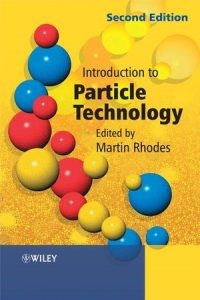[eBook] Introduction to Particle Technology 2nd Edition PDF by Martin Rhodes

Introduction to Particle Technology 2nd Edition by Martin Rhodes. Particle technology is a term used to refer to the science and technology related to the handling and processing of particles and powders.
Martin Rhodes wrote this book and as about Rhodes, he has research interests in various aspects of gas fluidization and particle technology, areas in which he has many refereed publications in journals and international conference proceedings. Martin is on the editorial boards of Powder Technology and KONA and on the advisory board of Advanced Powder Technology.
Contents
Introduction to Particle Technology Features:
Features of particle technology thus include:
- The behavior of solids in bulk.
- Size reduction including crushing and grinding.
- Increasing size by flocculation, granulation, and crystallization.
- Particle separation such as sieving, magnetic separation, and liquid filtration.
- Analytical procedures such as particle size analysis.
Table of contents:
1) Introduction
2) Particle characterization
3) Fluid flow through porous media
4) Liquid filtration
5) Dilute systems
6) Hindered systems and rheology
7) Fluidisation
8) Centrifugal separation
9) Conveying
10) Powder flow and storage
11) Crushing and classification
12) Solid/solid mixing
13) Colloids and agglomeration
14) Gas cleaning
15) Powder hazards
16) Case study
Particle characterization:
Particle characterization is of fundamental importance in particle technology because it provides the values used in the calculations.
Fluid flow through porous media:
A porous medium consists of pores between some particulate phase, contained within a vessel or some control volume.
Filtration of liquids:
Filtration is the removal of suspended particles from a fluid, performed by a filter medium, septum, cloth or bed of solids.
Dilute systems:
Dilute systems consider the behavior of a single particle suspended in a fluid.
Hindered systems and rheology:
On increasing the particle concentration from the low values, the system properties will change considerably from those of the continuous phase, usually water, and the individual particles.
Fluidization:
The fluidization principle is straightforward; passing a fluid upwards through a packed bed of solids produces a pressure drop due to fluid drag.
Centrifugal separation:
In a centrifugal field, the particle moves radially, and the radial position is part of the field force.
Conveying:
Conveying covers the transportation of particles by fluids.
Powder flow and storage:
Powder flow and storage means the higher the viscosity, the higher the pressure drop.
Crushing and classification:
Changing the size of the particles by crushing creates many important industrial products.
Solid/solid mixing:
The mixing of solids is a critically important operation in many industries.
Colloids and agglomeration:
It is the process of sticking particles together, either relying on natural adherence or by adding binding agents.
Gas cleaning:
In many industrial processes, sedimentation is the primary mechanism for particle removal from gas steam. Thus, gas-fluidized beds have a characteristic shape.
Powder hazards:
Some of the hazards posed by powders should be obvious. It has been split into two: explosion within a process and personal health process.
Case study:
The case study is entirely fictional, but it includes aspects appropriate to a large number of industries.
( More From Chemical Pdf: Ultrasound of the Musculoskeletal System Bianchi PDF )
Download Introduction to Particle Technology 2nd Edition by Martin Rhodes pdf:
Particle technology may be described as the study of materials dispersed within a continuous fluid. The particles may be solid, but they can also be oil droplets in water or water droplets in the air get more chemical engineering books from our website.